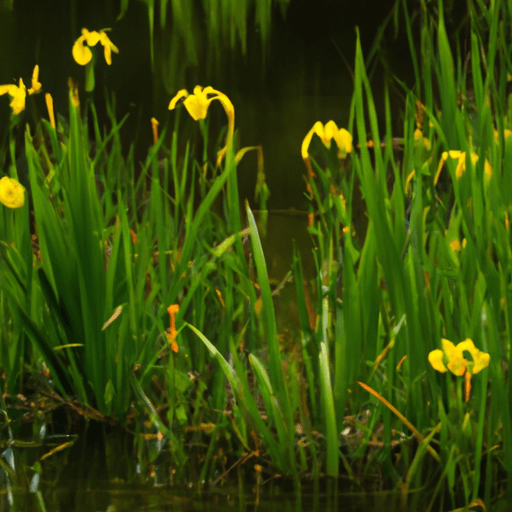Yellow flag iris is a beloved wetland plant that thrives in North America’s wetland areas. Its low-maintenance nature and ability to thrive in wet conditions make it a popular choice for gardeners. With its attractive flowers and sword-shaped leaves, this non-native plant adds beauty to any landscape.
While considered invasive in some states, there are safe ways to incorporate yellow flag iris into your garden. This guide will provide detailed information on the characteristics, ideal growing conditions, fertilizing and pruning techniques, as well as maintenance tips for yellow flag iris.
Characteristics and Benefits of Yellow Flag Iris
Yellow flag iris is valued for its attractive flowers, striking leaves, and the large seed pods that can be used in dry flower arrangements. This non-native plant is highly beneficial for wetland restoration projects due to its ability to grow in wet areas and its low-maintenance nature.
Additionally, yellow flag iris can attract pollinators to your garden, making it a great choice for those looking to support local wildlife. The plant’s vibrant flowers and sword-shaped leaves are particularly appealing to bees, butterflies, and hummingbirds.
Ideal Growing Conditions for Yellow Flag Iris
The ideal growing conditions for yellow flag iris include wet soils, constant moisture, and areas with high humidity. This plant thrives in water gardens and can also be grown in containers. Here are four key points to consider when growing yellow flag iris:
-
Wet Soils: Yellow flag iris prefers wet soils and requires constant moisture. It performs best in boggy soil, making it a perfect addition to water gardens.
-
Water Gardens: Full sun is preferred for yellow flag iris in water gardens. It can tolerate partial sun in garden settings, but for optimal growth and flowering, full sun is recommended.
-
Containers: Growing yellow flag iris in containers is possible, but it’s important to provide adequate moisture. Ensure the container has drainage holes and water the plant regularly to keep the soil consistently moist.
-
High Humidity: Yellow flag iris thrives in areas with high humidity. If you live in a drier climate, consider misting the plant or placing it near a source of water to increase humidity levels.
Fertilizing, Pruning, and Propagation Techniques
To promote healthy growth, gardeners can fertilize yellow flag iris with manure tea in late winter or early spring. Manure tea is a natural and organic fertilizer that provides essential nutrients to the plants. It can be made by soaking well-rotted manure in water for a few days, then straining the liquid and diluting it with water.
This fertilizer should be applied to the soil around the base of the plant, taking care not to get it on the leaves or flowers.
In terms of pruning, it is recommended to prune bloom-bearing stalks after the flower dies during the growing season. This helps to maintain the plant’s appearance and prevent seed pod formation. Additionally, in the fall, it is advised to prune any old or dead leaves by cutting the entire plant back to 1 inch.
These pruning methods help to keep the yellow flag iris healthy and encourage new growth.
Overwintering Tips and Alternative Options
After the foliage dies back completely in the fall, gardeners should trim the leaves of the yellow flag iris to 1 inch to prepare it for overwintering.
Here are some overwintering strategies for the yellow flag iris:
-
Avoid applying mulch over yellow flag iris plants, as it can promote rotting. However, in extremely cold winters, straw can be used as a protective layer.
-
Blue flag iris is a native alternative to yellow flag iris for water gardens. It has similar growing conditions and is indigenous to North America. With its stunning violet-blue flowers, it can be a beautiful substitute.
-
When planting yellow flag iris, choose a sunny or partially shaded location with well-draining soil. Plant the rhizome horizontally in the hole, with the top slightly exposed, and backfill with soil.
-
Regularly inspect the plants for signs of disease or pests and protect them from extreme temperatures and frost damage.
Best Practices for Planting and Maintenance of Yellow Flag Iris
When planting and maintaining yellow flag iris, gardeners should choose a sunny or partially shaded location with well-draining soil. Yellow flag iris grows best in wet soils and prefers constant moisture. It can tolerate partial sun in garden settings, but full sun is preferred in water gardens. Adequate watering is important, and it is difficult to overwater the plant.
Fertilize yellow flag iris with manure tea in late winter or early spring. The plant spreads through fast-growing underground rhizomes, making it easy to divide. After the blooming season, dig up a clump of yellow flag irises and separate the rhizomes into sections. Plant the rhizomes halfway into moist, rich soil and keep it well-watered.
When it comes to common pests, yellow flag iris is relatively resistant. However, gardeners should watch out for snails and slugs, which can damage the leaves. Regularly inspect the plants for signs of disease or pest infestation.
Overall, with proper planting techniques and maintenance, yellow flag iris can thrive in your garden or water feature.







